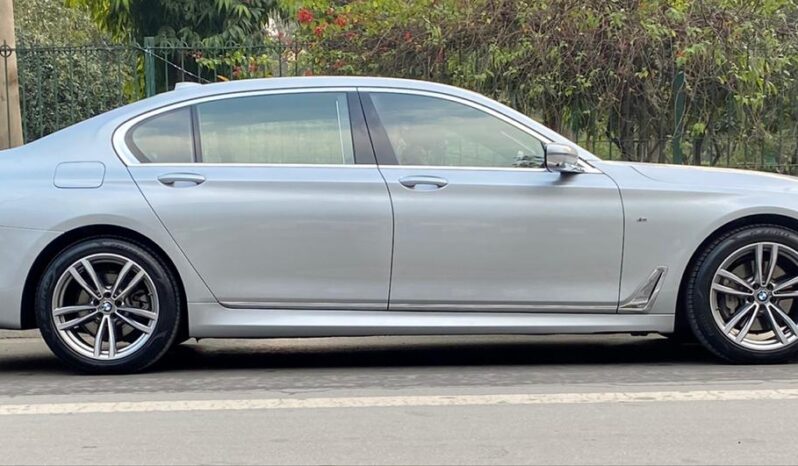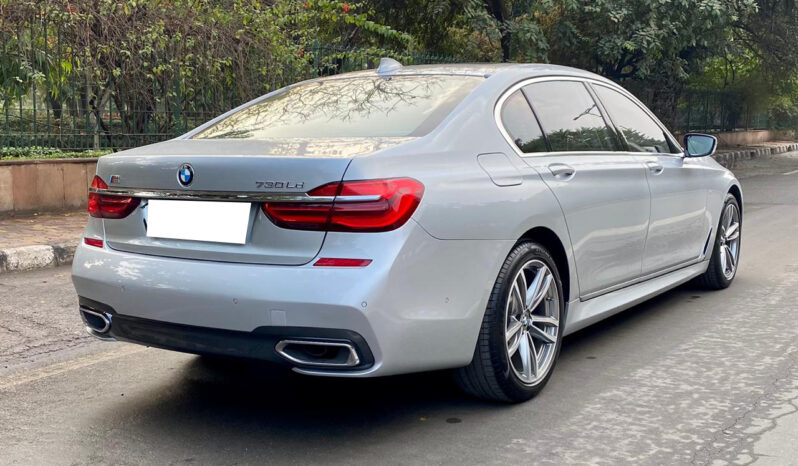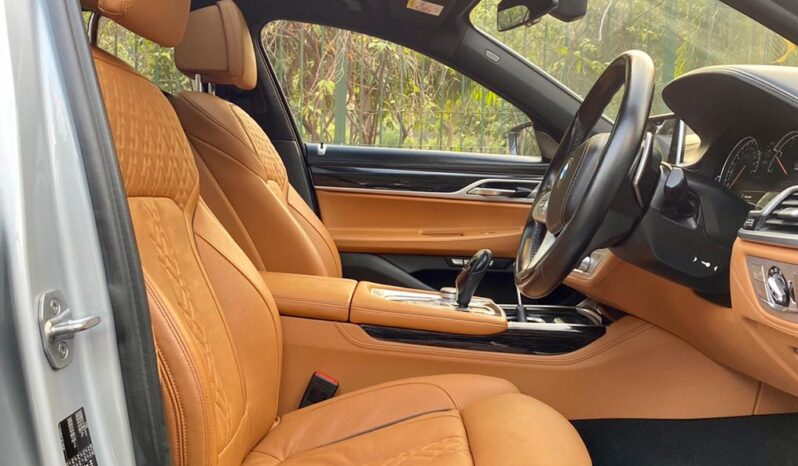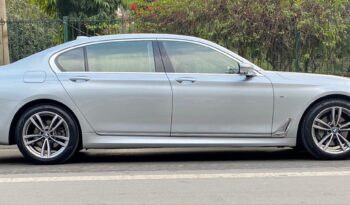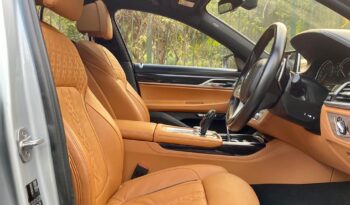The 2018 BMW 7-Series is a plush ride with plenty of powertrain options and customizable features that places it among the full-size greats.
The 2018 BMW 7-Series full-size luxury sedan is excellence hiding in plain sight. The flagship sedan from BMW may be lost among the company’s growing number of crossovers, but it shouldn’t be overlooked. The 7-Series features the automaker’s most advanced construction, its most powerful or most efficient engine, and the latest technology.
It earns a 8.2 out of 10 on our scale, which makes it one of the highest-rated cars we’ve tested.
For 2018, the 7-Series largely stands pat. Semi-autonomous driving features are now available on base models and advanced parking features such as a surround-view camera system are available on more models.
The 2018 BMW 740i will be the first stop for many buyers, but a plug-in hybrid 740e xDrive isn’t far off in price after applicable federal incentives. At the other end of the spectrum, a V-12-powered M760i xDrive sedan starts at more than $157,000 and ends its 60 mph sprint in 3.6 seconds.
The 7-Series is both efficient and quick thanks to its ultra lightweight construction that utilizes carbon fiber-reinforced plastics, high-strength steel, and aluminum to cut nearly 100 pounds from the body-in-white alone. With the lighter-weight construction comes an ideal weight balance of 50/50, which helps the big rear- or all-wheel-drive sedan seem to shrink, to feel more maneuverable.
For buyers that prefer to be driven, the 7-Series offers an executive rear-seat package including a 7.0-inch tablet to control climate functions, air conditioned and heated rear seats and NBA-sized leg room.
Creature comforts abound: a 12.3-inch touchscreen, a fold-out table for rear passengers, night-vision cameras, and a “Minority Report”-style controller that reads gestures to control functions like radio volume.
2018 BMW 7-Series
Styling
The 2018 BMW 7-Series’ looks can range from nerdy to butch, but all trims are closer to elegant than most anything else on the road.
The 2018 BMW 7-Series isn’t as daring as some of its contemporaries, but that may be the point. It’s a typical full-size luxury sedan, which is to say that it’s stately—not really stylish.
Its exterior is handsome and reserved, while its interior is another story altogether. It earns an 8 out of 10 on our style-o-meter. (Read more about how we rate cars.)
From the outside, the BMW 7-Series builds on the sedan’s rear-drive proportions with a long hood that’s punctuated by creases that run from nose to cabin. Along the sides, a belt line rises from the front fender and elegantly wraps around the rear and its taillights. Predictably, the V-12-powered M760i has flourishes of masculinity (if there’s such a thing) with butch tailpipes and a muscular lower front bumper. BMW’s corporate twin-kidney grille on the 7-Series is larger and taller than other models that wear the new nose, particularly the new 5-Series.
The 7-Series also shares its interior style with the 5-Series, albeit not as flashy. Whereas the mid-size sedan can wear higher-contrast combinations, the 7-Series is a mostly subdued affair with richer shades and a tonier feel to the interior trim materials. Most sedans will be swathed in vast expanses of leather, with customizable shades if your pockets are deep and your arms are long enough. In executive-trimmed sedans, the rear seats are deep and wildly comfortable, true to their mission of being a savagely plush limousine.
2018 BMW 7-Series
Performance
The 2018 BMW 7-Series impersonates a performance car with an available V-12, but we know better: it’s a handsome and comfortable cruiser.
The 2018 BMW 7-Series is motivated by a broad spectrum of powertrains, perhaps one of the largest spreads for any sedan on sale.
Its most efficient version is powered by a turbo-4 and a battery pack, its most powerful version is powered by a turbo-12 and your courage.
Every stop along the way, it’s a buttery soft ride, aided by BMW’s excellent 8-speed automatic transmission. We give it a surprising 8 out of 10 on our performance scale. Why? Performance isn’t the 7-Series’ mission, yet it’s still way above average.
Most versions will be powered by a turbocharged 3.0-liter inline-6 under the hoods of 740i models. That engine makes 320 horsepower and 330 pound-feet of torque and can power the rear or all four wheels when equipped with all-wheel drive, which is optional.
Compared to previous generations, the new BMW 740i is about 120 pounds lighter thanks to weight savings in the chassis. The result is a confident feeling behind the wheel of 740i models; it rarely feels out of breath.
The next step up is a step down to fewer cylinders, as it were. The 740e pairs a turbo-4 and a 9.2-kwh battery for a total system output of 322 hp. It’s the most efficient way to drive a 7-Series and also the most relaxed. We’ve had significant time behind the wheel of the 740e, and while the presentation and hybrid system seamlessly blend into the experience, it’s burdened by roughly 400 pounds over a comparable 740i and it feels that way. The trade-off is a 23-mile all-electric range in the 740e.
Those looking for a V-8 will find a fine example under the hood of the 750i. The 4.4-liter turbo V-8 makes 445 hp and can power the rear wheels only, or all wheels when optionally equipped with xDrive. Even though V-8s are a traditional pick for full-size buyers, this one feels like an outlier. It’s understandably not as efficient as the hybrid, nor is it strictly necessary; the turbo-6 is just fine. The V-8 isn’t on the top of the performance pyramid, either.
That distinction goes to the turbocharged 6.6-liter V-12 found in the M760i. It makes 601 hp and 590 lb-ft and powers the luxury sled up to 60 mph in less than four seconds. Any more power requires an ALPINA badge and deeper pockets. Our colleagues at Motor Authority have driven the ALPINA B7, read their report here.
Underneath that dizzying array of engines, BMW’s most sophisticated chassis and suspension in a sedan keeps all 7-Series models composed and smoother than a Steely Dan show.
BMW’s Carbon Core construction process, a combination of carbon fiber and composite materials, helps stiffen the chassis of the 7-Series and shed excess weight. All versions, even the base 740i, feel confident behind the wheel and work to iron out fussy roads.
Double wishbones up front and a five-link setup in the rear is complemented by a standard air suspension that dials from Comfort+ to Sport (or sharper in M760i trim) for a customized ride. Comfort+ is the floatiest setting, and while Sport helps shrink the car around the driver, it’s the only setting that will crash the 7-Series over pockmarked roads. We’re convinced it’s not the suspension’s doing—big wheels and low-profile, run-flat tires are famous for that.
Nonetheless, the 7-Series directs, slows, and redirects its motion with ease. The electric power steering is welcome here with a light, direct feel behind the wheel. It can be too quick in sportier modes, but that’s not the 7-Series’ best use anyhow.
2018 BMW 7-Series
Comfort & Quality
If the future is driverless, we’d prefer that it look like a BMW 7-Series. We could see ourselves stretched out in the back please.
We begrudge the imminent robot-car future with very few exceptions. The 2018 BMW 7-Series is among those special cases.
With a plush interior, creamy ride, and loads of tech, we can get behind a driver-less future if it comes with tray tables, a tablet computer and twin 10-inch entertainment screens.
By our book, the 7-Series has good front seats, rear seats, cargo space, fit, finish, luxury, whatever—it’s just great.
The front seats are nothing to sneeze at. Even base seats are all-day comfortable and shod with soft nappa hides. The big, supportive thrones can be tailor-made for your tush with customizable shades—for enough money, of course.
Rear-seat riders have plenty to brag about. The rear seats have 44.4 inches of leg room, made longer by a rear seat executive option that adds 3.5 inches, a foot rest for the right rear seat, fold-out tables, and twin 10-inch entertainment screens. Paired with another optional Luxury Rear Seat Package, the heated and cooled seats can soothe aching boardroom muscles with an in-seat massager, and a 7.0-inch popout tablet can control entertainment functions such as radio, media, climate, and navigation. The tablet can also instantly Google rising commodity prices, via the 7-Series built-in wifi hotspot, if your name happens to be Randolph or Mortimer Duke.
Increasingly so, full-size luxury sedans are as coveted for their technology as they are for their cosseting rides.
BMW’s iDrive system is covered separately, but infotainment is pertinent to quality in one respect: it’s ever-present. It takes time to learn the multiple (and sometimes redundant) features of the systems, but it’s needed to unlock the 7-Series’ potential as a high-roller. For instance: When equipped with Active Comfort systems, the BMW can use cameras and GPS information to “read” the road ahead to select the right gear and adjust the suspension for maximum comfort. We might prefer that six-figure cars don’t require a class to understand, but BMW isn’t alone in its complexity.
For old-world folks, the 7-Series is still awash in bourgeois decadence like rich wood, leather, metal materials, and soothing ambient light. Want details? Many of the buttons are covered with a thin layer of galvanized metal that makes them cool to the touch.
Scratch around: there’s wood in unexpected places, like the base of the rear pillar, that means BMW hasn’t skimped in hidden spaces. Wonderful.
2018 BMW 7-Series
Safety
Official safety data for the 7-Series isn’t available, but plenty of advanced safety systems are.
Federal and independent safety officials don’t have the guts—or money—to ruin a 2018 BMW 7-Series.
We don’t either. We can’t assign a safety score without official data. (Read more about how we rate cars.)
On top of the bleeding-edge materials used to make the 7-Series, the big Bimmer boasts a bunch of standard and optional safety equipment that can help prevent a crash.
As you’d expect, the 7-Series comes with a standard complement of safety equipment including front side, rear, and knee airbags in addition to the dual-stage airbags. Active head restraints help reduce whiplash and active headlights are newly standard.
A rearview camera was added to the standard equipment list this year (it probably should have been there all along, and it’s a federal requirement for 2018), and a suite of advanced safety features that includes adaptive cruise control, blind-spot monitors, night-vision cameras, and parking assistants.
BMW’s self-driving suite is available on the 7-Series as well, which can keep the big sedan in its own lane and steer itself for less than a minute. It’s a slick system, but lane positioning seems to be its Achilles heel compared to rivals from Mercedes-Benz and Audi.
BMW doesn’t run a charity, so expect to pay dearly for the latest and greatest. Top safety tech adds $3,400 to the 7-Series’ already high price.
2018 BMW 7-Series
Features
The 2018 BMW 7-Series is the automaker’s finest and most opulent sedan. Congratulations on your great success.
Luxury sedans are often the mountaintop for car tech—we wait for it to roll down to us.
The 7-Series nearly aces our features scale for good reason: it’s plentiful in base equipment, opulent and infinitely customizable from there, and it has a good infotainment system. To go any further would require something that makes the 7-Series stand out among competitors, and we’re not sure it’s there. We give it a 9. (Read more about how we rate cars.)
Most people may consider the 2.2-inch touchscreen keyfob as a big deal, but we say it’s just big. The fob can air condition the car before you’ve set foot in it, navigate the 7-Series into tight parking spaces, or even tell you the status of your car—all things that might also be done on a smartphone that’s already in your pocket.
Others could point to the 7-Series’ gesture control that controls the radio via cameras that read specific hand gestures to “wind” up the volume, or “swipe” for camera perspectives, or “stab” for next tracks. We’d just rather not point.
And so on. Looking for a single feature in the 7-Series overlooks the plentiful standard equipment that awaits buyers willing to spend $82,095 to start.
Base 740i models are equipped with leather seats, 18-inch wheels, wood trim, adjustable air suspension, LED headlights, power adjustable front seats, a Harman Kardon sound system with 16 speakers, 12.3 inch driver information display, 10.2-inch touchscreen, dual-panel sunroof, and power everything—including trunk lid.
Popular optional features will include heated front and rear seats and Apple CarPlay, which we think should be standard on a luxury car of its ilk.
From there, the limit is really only your wallet—not just your imagination. BMW offers a slew of packages to help make the 7-Series safer (two driving assistance levels that ramp up to semi-autonomous), or make the 7-Series smarter (four-wheel steering and constant damper monitors), or make the 7-Series swankier (custom leather hides and ceramic control knobs), sportier (M Sport brakes), or make the 7-Series sumptuous (dictator-grade rear seat executive packages with massagers and entertainment).
Our favorites: An optional Luxury Rear Seat Package that warms the armrests and bathes the interior in myriad selectable hues for $1,800. Not enough? An optional $3,400 Bowers & Wilkins “Diamond” surround sound system is equally eye-watering in price and sound clarity.
A remote parking system is available for the 7-Series that can guide the big sedan forward or backward into and out of parking spaces. It’s a nice feature for urban dwellers in skinny parking spaces, or to impress your friends and family with once, but not much help from there.
Most versions of the 7-Series are equipped similarly, but opting for higher trims brings with it bigger wheels (the 750i has 19-inchers, the M760i rides on 20s). Each model offers its own touch too: the 740e plug-in hybrid has a badge delete for the hybrid running gear because being eco-friendly doesn’t require notifying the neighbors; and the M760i has red-painted calipers.
2018 BMW 7-Series
Fuel Economy
Fuel efficiency in the 2018 BMW 7-Series follows a predictable path from plug-in hybrid versions to fire-breathing V-12 models.
BMW offers the 7-Series in a wide array of engine sizes, ranging from a plug-in hybrid inline-4 to a twin-turbocharged V-12. Predictably, the EPA had to break out their calculators.
Most examples will be 740i models, which are powered by an inline-6 that the EPA rates at 20 mpg city, 29 highway, 23 combined with all-wheel drive. That’s how we arrived at our rating of 6 out of 10 for efficiency. (Read more about how we rate cars.)
Those numbers go up or down from there. Opting for the V-8 found in the 750i drops those numbers significantly to 16/25/19 mpg. Opting for rear-wheel drive in the 740i or 750i adds 1 mpg across the board, give or take.
The plug-in hybrid 740e is rated for all-electric travel of up to 23 miles (up to 75 mph), or is rated at 27 mpg combined.
The V-12-powered M760i will manage 13/20/16 mpg according to the EPA.

